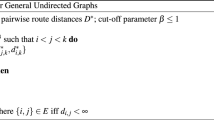Abstract
Given a spatial network and a collection of activities (e.g., pedestrian fatality reports, crime reports), Significant Route Discovery (SRD) finds all shortest paths in the spatial network where the concentration of activities is unusually high (i.e., statistically significant). SRD is important for societal applications in transportation safety, public safety, or public health such as finding routes with significant concentrations of accidents, crimes, or diseases. SRD is challenging because 1) there are a potentially large number of candidate routes (~1016) in a given dataset with millions of activities or road network nodes and 2) significance testing does not obey the monotonicity property. Previous work focused on finding circular areas of concentration, limiting its usefulness for finding significant linear routes on a network. SaTScan may miss many significant routes since a large fraction of the area bounded by circles for activities on a path will be empty. This paper proposes a novel algorithm for discovering statistically significant routes. To improve performance, the proposed algorithm features algorithmic refinements that prune unlikely paths and speeds up Monte Carlo simulation. We present a case study comparing the proposed statistically significant network-based analysis (i.e., shortest paths) to a statistically significant geometry-based analysis (e.g., circles) on pedestrian fatality data. Experimental results on real data show that the proposed algorithm, with our algorithmic refinements, yields substantial computational savings without reducing result quality.
Access this chapter
Tax calculation will be finalised at checkout
Purchases are for personal use only
Preview
Unable to display preview. Download preview PDF.
Similar content being viewed by others
References
Ernst, M., Lang, M., Davis, S.: Dangerous by design: Solving the epidemic of preventable pedestrian deaths. Transportation for America: Surface Transportation Policy Partnership, Washington, DC (2011)
National Highway Traffic Safety Administration (NHTSA): Fatality Analysis Reporting System (FARS) Encyclopedia, http://www.nhtsa.gov/FARS
Kulldorff, M.: A spatial scan statistic. Communications in Statistics-Theory and Methods 26(6), 1481–1496 (1997)
Neill, D.B., Moore, A.W.: Rapid detection of significant spatial clusters. In: Proceedings of the Tenth ACM SIGKDD International Conference on Knowledge Discovery and Data Mining, pp. 256–265. ACM (2004)
Kulldorff, M., Mostashari, F., Duczmal, L., Katherine Yih, W., Kleinman, K., Platt, R.: Multivariate scan statistics for disease surveillance. Statistics in Medicine 26(8), 1824–1833 (2007)
Kulldorff, M.: Spatial scan statistics: Models, calculations, and applications. In: Scan Statistics and Applications, pp. 303–322. Springer (1999)
Costa, M.A., Assunção, R.M., Kulldorff, M.: Constrained spanning tree algorithms for irregularly-shaped spatial clustering. Computational Statistics & Data Analysis 56(6), 1771–1783 (2012)
Duczmal, L., Assuncao, R.: A simulated annealing strategy for the detection of arbitrarily shaped spatial clusters. Computational Statistics & Data Analysis 45(2), 269–286 (2004)
Shi, L., Janeja, V.P.: Anomalous window discovery for linear intersecting paths. IEEE Transactions on Knowledge and Data Engineering 23(12), 1857–1871 (2011)
Janeja, V.P., Atluri, V.: Ls 3: A linear semantic scan statistic technique for detecting anomalous windows. In: Proceedings of the 2005 ACM Symposium on Applied Computing, pp. 493–497. ACM (2005)
Li, X., Han, J., Lee, J.-G., Gonzalez, H.: Traffic density-based discovery of hot routes in road networks. In: Papadias, D., Zhang, D., Kollios, G. (eds.) SSTD 2007. LNCS, vol. 4605, pp. 441–459. Springer, Heidelberg (2007)
Ester, M., Kriegel, H.P., Sander, J., Xu, X.: A density-based algorithm for discovering clusters in large spatial databases with noise. In: KDD, vol. 96, pp. 226–231 (1996)
MacQueen, J., et al.: Some methods for classification and analysis of multivariate observations. In: Proceedings of the fifth Berkeley Symposium on Mathematical Statistics and Probability, vol. 1, pp. 281–297 (1967)
Oliver, D., Bannur, A., Kang, J.M., Shekhar, S., Bousselaire, R.: A K-Main Routes Approach to Spatial Network Activity Summarization: A Summary of Results. In: IEEE International Conference on Data Mining Workshops (ICDMW), pp. 265–272 (2010)
Buchin, K., Cabello, S., Gudmundsson, J., Löffler, M., Luo, J., Rote, G., Silveira, R.I., Speckmann, B., Wolle, T.: Finding the most relevant fragments in networks. J. Graph Algorithms Appl. 14(2), 307–336 (2010)
Chawla, S., Roughgarden, T.: Single-source stochastic routing. In: Díaz, J., Jansen, K., Rolim, J.D.P., Zwick, U. (eds.) APPROX/RANDOM 2006. LNCS, vol. 4110, pp. 82–94. Springer, Heidelberg (2006)
Shekhar, S., Liu, D.: CCAM: A connectivity-clustered access method for networks and network computations. IEEE Transactions on Knowledge and Data Engineering 9(1), 102–119 (1997)
Cormen, T.: Introduction to algorithms. The MIT press (2001)
Kulldorff, M., Rand, K., Gherman, G., Williams, G., DeFrancesco, D.: SaTScan v 2.1: Software for the spatial and space-time scan statistics. National Cancer Institute, Bethesda (1998)
The QGIS Project: Quantum GIS OpenLayers Plugin, http://plugins.qgis.org/plugins/openlayers_plugin/ (accessed: January 23, 2014)
US Census Bureau: Census TIGER/Line Shapefiles (2010), http://www.census.gov/geo/maps-data/data/tiger-line.html (accessed: January 23, 2014)
Author information
Authors and Affiliations
Editor information
Editors and Affiliations
Rights and permissions
Copyright information
© 2014 Springer International Publishing Switzerland
About this paper
Cite this paper
Oliver, D. et al. (2014). Significant Route Discovery: A Summary of Results. In: Duckham, M., Pebesma, E., Stewart, K., Frank, A.U. (eds) Geographic Information Science. GIScience 2014. Lecture Notes in Computer Science, vol 8728. Springer, Cham. https://doi.org/10.1007/978-3-319-11593-1_19
Download citation
DOI: https://doi.org/10.1007/978-3-319-11593-1_19
Publisher Name: Springer, Cham
Print ISBN: 978-3-319-11592-4
Online ISBN: 978-3-319-11593-1
eBook Packages: Computer ScienceComputer Science (R0)




